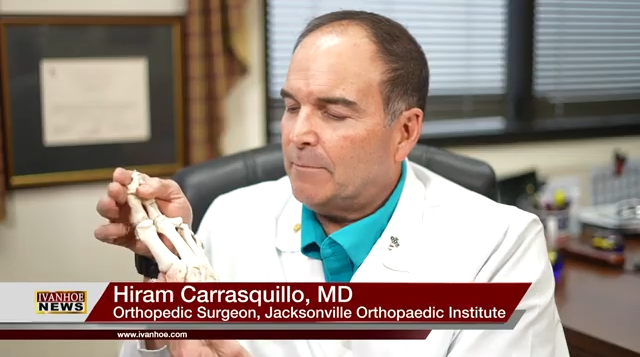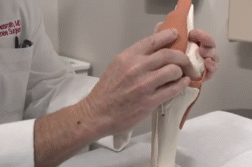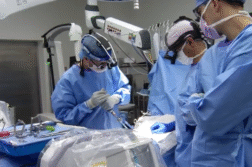Hiram Carrasquillo, MD, Orthopedic Surgeon at Jacksonville Orthopaedic Institute talks about a new bunion procedure.
Interview conducted by Ivanhoe Broadcast News in 2024.
We’re talking bunions today and bunions are a huge problem for a lot of people, more widespread than you imagine.
Carrasquillo: Almost 25 percent of U.S. adults have bunions that may become symptomatic.
Most people think it’s something that happens mostly to women because we’ve abused our feet with high heels and stilettos.
Carrasquillo: Certainly, even though most of the patients with bunions are female, bunions can occur in anyone, it’s not just an issue with ladies. It can happen to men and even adolescents.
What causes it? Is it hereditary?
Carrasquillo: It’s multifactorial, meaning that there are different causes for it. The condition is often aggravated by from tight shoes. Most bunions run in families. There are some that develop because of trauma as well.
I’ve never heard about them in kids before. That’s something new.
Carrasquillo: There is such a thing called congenital bunion deformity. Bunions are a result of multiple factors, most of which are genetic. Some are traumatic, and some are made worse because of wearing tight shoes.
I’ll tell you I have them and from doing stories on bunion surgeries a decade ago or 15 years ago, I’m scared to death to do anything about them but that’s not necessarily the case.
Carrasquillo: No, it’s not a scary proposition anymore. Certainly, each patient should work with their doctor to find the treatment option that best fits their needs and lifestyle but with newer surgical options, recovery is often not as painful as most people think.
Traditionally, how were they treated?
Carrasquillo: In the past, we would perform a simple bunionectomy which involves just shaving some of the bony prominences and doing more bone cuts and trying to move the bunion into the foot to be less prominent but those tend to have a high rate of recurrence. Over the past few years, we’ve started using more three-dimensional approaches like the Lapiplasty Procedure these days. This approach has a demonstrated low risk of recurrence and allows patients to get back to their usual activities relatively quickly.
What is Lapiplasty?
Carrasquillo: Lapiplasty uses a three-dimensional approach to correc the bunion deformity. It not only involves moving the bones into their correct planes but also corrects the rotation that takes place with the bunion deformity.
Can you explain it in a little bit more detail?
Carrasquillo: A bunion is caused by instability in the mid-foot that allows that bones to slide out of place, creating the bony prominence on the side of the toe. The actual base of the metatarsal, the long bone into the foot, is where the problem starts. Now correcting the rotation and the angle allows us to correct the bunion without even having to cut any bone in most people around the bunion area. There’s some special instrumentation that Treace created to allow for a precise and reproducible correction so we can make specific cuts that not only correct up and down and side to side but also help with the correction of the rotational deformity.
What’s the recovery like? I remember this patient and she was sitting at home for six weeks with drainage things coming out of her foot. Is it still the same?
Carrasquillo: No, ma’am. It’s an outpatient procedure. Most patients go home the same day. Most of the procedures are done with the help of a nerve block. That means that we perform a procedure before the surgery that numbs the foot. That allows many patients to be pain-free after surgery until the block wears off. In my professional experience, most patients use pain medication for a day or two, if at all. Most people start moving around immediately, although non-weight bearing until their physician clears them, which usually takes about 10 days to two weeks in my experience.
And that’s it, 10 days?
Carrasquillo: To start putting some weight on it while wearing a surgical walking boot. Yes.
Is there anyone that’s a better candidate for this than other people?
Carrasquillo: Certainly, for people who failed conservative treatment where shoe modifications and limitations and activities are not an option because of lifestyle or persistent pain, those are good indications for the surgery.
When you saw Paul, what was he like?
Carrasquillo: Paul is a very active individual as you probably know. He’s young, and he enjoys running. He was asking when he could run from the get-go before we finished explaining the whole procedure.
Can you explain what his foot was like when you first saw it and how much has been corrected?
Carrasquillo: Paul presented with a typical bunion in deformity with the widening of the forefoot bunion prominence on the inner aspect of the big toe. That was painful and was difficult for him to wear shoes and engage in activities of daily living and running.
Is he back to 100 percent normal now?
Carrasquillo: I will say that he’s very close to 100 percent. He’s back to running long distance, running over 50 miles.
Is there anything that you can’t do after the surgeries?
Carrasquillo: Well, like many surgical procedures, the immediate post-op is quite restrictive. You want to control swelling and you don’t want to do anything that causes additional problems with wound healing but once the wounds are healed, you can start increasing your activity. For most people, in four to six weeks they’re able to return to light activities and probably in about eight weeks, most people are starting to get into a regular shoe.
Perfect. And one of these things, like if it is not hereditary but done by you, like your shoe and everything, is it something that you can never go back to those shoes again or?
Carrasquillo: Well, most people return to normal regular shoe sizes once the swelling subsides.
Anything I’m missing? Can we just do a little comparison about, traditional surgery versus this like maybe it’s like time in the operating room recovery time, medication?
Carrasquillo: Yes. So the typical correction back in the day mostly involved a single plane correction or two dimensional correction where you’d remove some of the bony prominence. With the Lapiplasty® Procedure, we are able to move the bones side to side and rotate them where they should be anatomically in a normal patient. The time of surgery varies depending on the procedure and the patient. Some people have more than one problem, and they go through surgery at the same time but with the Lapiplasty® Procedure, the recovery generally straightforward and relatively quick, and the chances of recurrence are very low. I think that’s the most dramatic change that I’ve seen throughout my 30 years in practice.
Would you have to have a specific number that was much lower?
Carrasquillo: The Lapiplasty® Procedure has demonstrated a recurrence risk of 1-3% in 13- and 17-month clinical studies, respectively. It’s a dramatic improvement.
END OF INTERVIEW
This information is intended for additional research purposes only. It is not to be used as a prescription or advice from Ivanhoe Broadcast News, Inc. or any medical professional interviewed. Ivanhoe Broadcast News, Inc. assumes no responsibility for the depth or accuracy of physician statements. Procedures or medicines apply to different people and medical factors; always consult your physician on medical matters.
If you would like more information, please contact:
Kaitlin Gallagher
Sign up for a free weekly e-mail on Medical Breakthroughs called First to Know by clicking here




